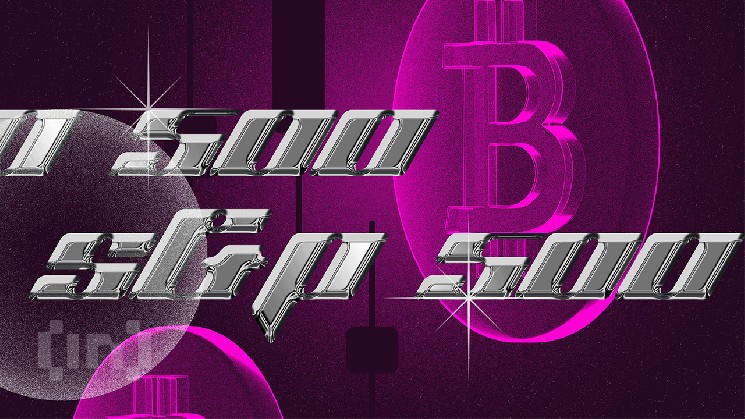Bitcoin and S&P 500 Correlation Turns Negative for the First Time Since FTX Collapse

In recent days, the largest traditional stock market index, the S&P 500 (SPX), has stopped correlating positively with Bitcoin (BTC).
This situation occurred for the first time since the FTX collapse in November 2022 and for the second time in the last 14 months. Does this mean that Bitcoin can again be seen as a hedge against inflation?
Unfulfilled Promise
The narrative that Bitcoin is such a hedge gained popularity before inflation became a global concern. It was expected that in a situation of uncontrolled fiat money printing, BTC and other significant cryptocurrencies would respond with increases or at least maintain their value. This would be indicated by the logic of supply and demand and the crypto-guaranteed inability to ‘print’ Bitcoin.
However, the inflation surge in most global economies in 2022 coincided with a cryptocurrency bear market. There are claims that it peaked in inflation of national currencies not seen in 40 years. Which led to a deeper decline in cryptocurrencies and other risk assets. In the United States, the CPI peaked at 9.1% in June 2022. While in the European Union, it reached 10.6% in October 2022.
High inflation triggered a natural response to quantitative tightening policies. Including a decrease in liquidity and money supply, and an increase in interest rates. The biggest winner was the U.S. dollar index (DXY), which began its bull market in June 2021. Risky assets – such as indexes of exchange-traded companies and cryptocurrencies – headed south.
So, it seems that Bitcoin has not lived up to the hopes placed in it. Therefore, in a moment of trial, succumbed to the iron rules of financial markets and the slogan: “Cash is king.” However, there is a spark of hope for cryptocurrency maximalists. If it turned out that Bitcoin could behave differently from traditional assets (symbolized by the SPX index), lose correlation to them, and go its own way, then perhaps the inflation hedging narrative would find its second life.
BTC Loses Correlation With SPX
In recent days, an interesting and rare phenomenon has appeared on the correlation chart between Bitcoin and the S&P 500. It was pointed out by well-known on-chain analyst @WClementeIII. Clemente wrote that for the first time since the FTX collapse, the daily correlation has become negative:
A closer look at the daily charts of BTC, SPX, and their correlation (blue) shows that for the vast majority of 2022, the assets remained in a strong positive correlation. Excluding the FTX crash in November 2022, the last time the correlation was negative was December 2021 (orange line).
Moreover, the FTX crash led to a strong plunge in the cryptocurrency market. As well as a drop in Bitcoin price (red area). In contrast, SPX continued its upward movement (green area). Therefore, the previous loss of correlation played out to the disadvantage of BTC.

BTC/USD chart by Tradingview
SPX Correction a Bullish Signal for Bitcoin?
However, the current loss of correlation could lead to the opposite effect. Recently, SPX recorded its first higher peak in many months and broke through resistance at $4100. However, this bullish event was followed by a correction and a decline to the current level near $4000.
Cryptocurrency analyst @24KCrypto tweeted his SPX price prediction today. In his opinion, the index needs to complete a structure of a flat A-B-C correction with a bottom in the $3800 area. Only after this level is validated, he believes, will an impulsive upward movement begin.
If this happens, and Bitcoin maintains a negative correlation with SPX, the coming weeks could be bullish for the largest cryptocurrency. In such a situation, BTC will not only decouple from the traditional stock market but will also have a chance to once again capture investors’ appreciation as a hedge against inflation.






 Bitcoin
Bitcoin  Ethereum
Ethereum  Tether
Tether  USDC
USDC  TRON
TRON  Dogecoin
Dogecoin  Cardano
Cardano  Bitcoin Cash
Bitcoin Cash  Chainlink
Chainlink  LEO Token
LEO Token  Monero
Monero  Zcash
Zcash  Stellar
Stellar  Litecoin
Litecoin  Hedera
Hedera  Dai
Dai  Cronos
Cronos  OKB
OKB  Tether Gold
Tether Gold  Ethereum Classic
Ethereum Classic  KuCoin
KuCoin  Gate
Gate  Algorand
Algorand  Cosmos Hub
Cosmos Hub  VeChain
VeChain  Stacks
Stacks  Tezos
Tezos  Dash
Dash  TrueUSD
TrueUSD  IOTA
IOTA  Basic Attention
Basic Attention  Theta Network
Theta Network  Decred
Decred  NEO
NEO  Synthetix
Synthetix  Qtum
Qtum  Ravencoin
Ravencoin  0x Protocol
0x Protocol  DigiByte
DigiByte  Zilliqa
Zilliqa  Nano
Nano  Siacoin
Siacoin  Numeraire
Numeraire  Waves
Waves  Status
Status  Ontology
Ontology  Enjin Coin
Enjin Coin  Hive
Hive  BUSD
BUSD  Lisk
Lisk  Pax Dollar
Pax Dollar  Steem
Steem  Huobi
Huobi  NEM
NEM  OMG Network
OMG Network  Bitcoin Gold
Bitcoin Gold  Augur
Augur  Bitcoin Diamond
Bitcoin Diamond